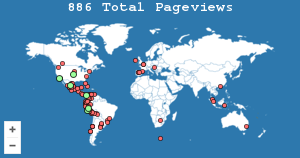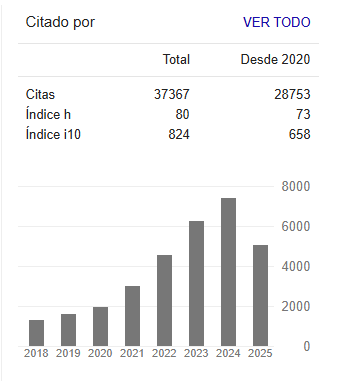Emprendimiento femenino y crecimiento empresarial: análisis bibliométrico
Abstract
El objetivo de este trabajo es el de analizar, a través de un análisis bibliométrico, la literatura académica relacionada con el emprendimiento femenino y su crecimiento empresarial. Para ello, se utilizaron los 207 trabajos de investigación publicados en la base de datos Scopus. Las técnicas bibliométricas permitieron describir, la evolución científica, los autores más productivos, las instituciones de educación superior más prolíferas y la tendencia de subtemas, entre otros aspectos. El emprendimiento femenino es considerado un indicador de impacto socioeconómico, por lo cual se han incrementado el número de investigaciones que permitan esclarecer el conocimiento científico sobre este tema, y generar políticas públicas que incidan en cerrar las brechas de género (Terjesen et al, 2016). Aunque existen análisis bibliométricos sobre el estudio del emprendimiento femenino, no existe ninguno sobre la relación entre el crecimiento empresarial de los emprendimientos generados por mujeres.
References
Agarwal, S., Ramadani, V., Dana, L.-P., Agrawal, V., & Dixit, J. K. (2022). Assessment of the significance of factors affecting the growth of women entrepreneurs: study based on experience categorization. Journal of Entrepreneurship in Emerging Economies, 14(1), 111–136. https://doi.org/10.1108/jeee-08-2020-0313
Akehurst, G., Simarro, E., & Mas-Tur, A. (2012). Women entrepreneurship in small service firms: motivations, barriers and performance. Service Industries Journal, 32(15), 2489–2505. https://doi.org/10.1080/02642069.2012.677834
Arcuri, M. C., Gandolfi, G., & Russo, I. (2023). Exploring the impact of innovation intensity on the growth of female-led entrepreneurial firms. Journal of Small Business and Enterprise Development, 30(5), 947–966. https://doi.org/10.1108/jsbed-04-2022-0209
Aria, A. y Cuccurullo, C. (2017). Bibliometrix: An R-tool for Comprehensive science mapping. Journal of Informetric, 11, 959-975. https://doi.org/10.106/j.joi.2017.09.007
Cardella, G. M., Hernández-Sánchez, B. R., & Sánchez García, J. C. (2020). Entrepreneurship and family role: A systematic review of a growing research. Frontiers in psychology, 10. https://doi.org/10.3389/fpsyg.2019.02939
Cardella, G. M., Hernández-Sánchez, B. R., & Sánchez-García, J. C. (2020). Women entrepreneurship: A systematic review to outline the boundaries of scientific literature. Frontiers in psychology, 11. https://doi.org/10.3389/fpsyg.2020.01557
Cliff, J. E. (1998). Does one size fit all? exploring the relationship between attitudes towards growth, gender, and business size. Journal of Business Venturing, 13(6), 523–542. https://doi.org/10.1016/s0883-9026(97)00071-2
Donthu, N., Kumar, S., Mukherjee, D., Pandey, N., & Lim, W. M. (2021). How to conduct a bibliometric analysis: An overview and guidelines. Journal of Business Research, 133, 285–296. https://doi.org/10.1016/j.jbusres.2021.04.070
Elam, A. B., Brush, C. G., Greene, P. G., Baumer, B., Dean, M., and Heavlow, R. (2019). Global Entrepreneurship Monitor 2018/2019 Women’s Entrepreneurship Report. Babson College: Smith College and the Global Entrepreneurship Research Association.
Falagas, M. E., Pitsouni, E. I., Malietzis, G. A., & Pappas, G. (2008). Comparison of PubMed, Scopus, Web of Science, and Google Scholar: strengths and weaknesses. FASEB Journal: Official Publication of the Federation of American Societies for Experimental Biology, 22(2), 338–342. https://doi.org/10.1096/fj.07-9492lsf
Faradis, R., & Afifah, U. N. (2018). Mirroring to the Greek’s tourism after economy crisis: The effect of tourism sector to Bangka Belitung GDRP. Journal of Regional and Rural Development Planning, 2(2), 185. https://doi.org/10.29244/jp2wd.2018.2.2.185-194
Garfield, E. (1972). Citation Analysis as a Tool in Journal Evaluation: Journals can be ranked by frequency and impact of citations for science policy studies. Science (New York, N.Y.), 178(4060), 471–479. https://doi.org/10.1126/science.178.4060.471
Guzman, J., & Kacperczyk, A. (olenka). (2019). Gender gap in entrepreneurship. Research Policy, 48(7), 1666–1680. https://doi.org/10.1016/j.respol.2019.03.012
Hechavarria, D., Bullough, A., Brush, C., & Edelman, L. (2019). High-growth women’s entrepreneurship: Fueling social and economic development: Journal of small business management. Journal of Small Business Management, 57(1), 5–13. https://doi.org/10.1111/jsbm.12503
Hirsch, J. E. (2005). An index to quantify an individual’s scientific research output. Proceedings of the National Academy of Sciences of the United States of America, 102(46), 16569–16572. https://doi.org/10.1073/pnas.0507655102
Lechuga-Sancho, M.-P., Martínez-Fierro, S., & Ramos-Rodríguez, A. R. (2023). Thirty years of research on high-growth entrepreneurship: bibliometric overview of its H-Classics. Profesional De La información, 32(3). https://doi.org/10.3145/epi.2023.may.20
Leyva-Osuna, B. A., Sonora, I. T. de, Flores-Lopez, J. G., Garcia-Garcia, A. R., Sonora, I. T. de, & Sonora, I. T. de. (2023). Emprendimiento y género: un análisis bibliométrico. Espacios: ciencia, tecnologia y desarrollo, 44(08), 01–15. https://doi.org/10.48082/espacios-a23v44n08p01
Marlow, S., & McAdam, M. (2013). Gender and entrepreneurship: Advancing debate and challenging myths; exploring the mystery of the under-performing female entrepreneur. International Journal of Entrepreneurial Behaviour & Research, 19(1), 114–124. https://doi.org/10.1108/13552551311299288
Martín-Navarro, A., Lechuga Sancho, M. P., & Martínez-Fierro, S. (2023). Evolution of entrepreneurship research in the food sector: a bibliometric review. British Food Journal (Croydon, England), 125(5), 1537–1558. https://doi.org/10.1108/bfj-04-2022-0388
Minniti, M., & Naudé, W. (2010). What do we know about the patterns and determinants of female entrepreneurship across countries? European Journal of Development Research, 22(3), 277–293. https://doi.org/10.1057/ejdr.2010.17
Ngoasong, M. Z., & Kimbu, A. N. (2019). Why hurry? The slow process of high growth in women-owned businesses in a resource-scarce context: Journal of small business management. Journal of Small Business Management, 57(1), 40–58. https://doi.org/10.1111/jsbm.12493
Ordóñez, M., Useche, M.C., Rodríguez, R. T., y Ruiz, P. I. (2022). Emprendimiento Femenino en el desarrollo local en Ecuador. Revista Venezolana de Gerencia, 27 (7), 73-87. https://doi.org/10.52080/rvgluz.27.7.6.
Powell, G. N., & Eddleston, K. A. (2013). Linking family-to-business enrichment and support to entrepreneurial success: Do female and male entrepreneurs experience different outcomes? Journal of Business Venturing, 28(2), 261–280. https://doi.org/10.1016/j.jbusvent.2012.02.007
Rahman, M.M., Salamzadeh, A., y Dana, L.P. (2024). Shackled feet: A review of women entrepreneurs’ challenges in developing countries. Entrepreneurial Business and Economics Review, 12(1), 177-193. https://doi.org/10.15678/EBER.2023.120110
Ramos-Rodriguez, A.-R., Lechuga Sancho, M. P., & Martínez-Fierro, S. (2021). Authorship trends and collaboration patterns in hospitality and tourism research. International Journal of Contemporary Hospitality Management, 33(4), 1344–1367. https://doi.org/10.1108/ijchm-09-2020-0981
Salazar-Botello, C. M., Ganga-Contreras, F., Fossatti, P., Muñoz-Jara, Y., & Monje-Sanhueza, R. (2023). Evolución del aprendizaje servicio: un análisis bibliométrico desde la Web Of Science. Bibliotecas, Anales de Investigacion, 19(1), 17-29. https://tarapaca.elsevierpure.com/en/publications/evoluci%C3%B3n-del-aprendizaje-servicio-un-an%C3%A1lisis-bibliom%C3%A9trico-desd
Sánchez, Y., Macías, M. Á. y Mendoza, J. E. (2021). Diferencias en los determinantes del éxito en el emprendimiento en México, una perspectiva de género. Revista Venezolana De Gerencia, 26(94), 880-902. https://doi.org/10.52080/rvgv26n94.25
Sarfaraz, L., Faghih, N., & Majd, A. (2014). The relationship between women entrepreneurship and gender equality. Journal of Global Entrepreneurship Research, 2(1), 6. https://doi.org/10.1186/2251-7316-2-6
Schwartz, D. J. (1976). Implications for personnel measurement1. Personnel Psychology, 29(4), 521–526. https://doi.org/10.1111/j.1744-6570.1976.tb02073.x
Secinaro, S., Calandra, D., Lanzalonga, F. y Ferrqris, A. (2022). Electric vehicles’ consumers behaviors: mapping the field and providing a research agenda. Journal of Business Research, 150, 399-416.
Tayebi, S. M., Manesh, R. R., Khalili, M. y Sadi-Nezhad, S. (2019). The role of information systems in communication through social media. International Journal of Data and Network Science, 2, 245-268. https://doi.org/112.5267/j.ijdns.2019.2.002.
Terjesen, S., Bosma, N., & Stam, E. (2016). Advancing public policy for high‐growth, female, and social entrepreneurs. Public Administration Review, 76(2), 230–239. https://doi.org/10.1111/puar.12472
Verheul, I., & Thurik, R. (2001). Small business economics, 16(4), 329–346. https://doi.org/10.1023/a:1011178629240
Yadav, V., & Unni, J. (2016). Women entrepreneurship: research review and future directions. Journal of Global Entrepreneurship Research, 6(1). https://doi.org/10.1186/s40497-016-0055-x
Zupic, I., & Čater, T. (2015). Bibliometric methods in management and organization. Organizational Research Methods, 18(3), 429–472. https://doi.org/10.1177/1094428114562629

This work is licensed under a Creative Commons Attribution-NonCommercial-ShareAlike 4.0 International License.








.png)






























